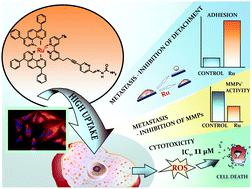当前位置:
X-MOL 学术
›
Metallomics
›
论文详情
Our official English website, www.x-mol.net, welcomes your feedback! (Note: you will need to create a separate account there.)
Unexplored features of Ru(ii) polypyridyl complexes - towards combined cytotoxic and antimetastatic activity.
Metallomics ( IF 3.4 ) Pub Date : 2020-03-19 , DOI: 10.1039/d0mt00019a Ilona Gurgul 1 , Olga Mazuryk , Michał Łomzik , Philippe C Gros , Dorota Rutkowska-Zbik , Małgorzata Brindell
Metallomics ( IF 3.4 ) Pub Date : 2020-03-19 , DOI: 10.1039/d0mt00019a Ilona Gurgul 1 , Olga Mazuryk , Michał Łomzik , Philippe C Gros , Dorota Rutkowska-Zbik , Małgorzata Brindell
Affiliation

|
The well-documented cytotoxic activity of coordinatively saturated and substitutionally inert polypyridyl Ru(II) complexes substantiates their high potency as antiproliferative agents against primary tumors. However, the primary cause of cancer morbidity and mortality responsible for about 90% of cancer deaths is the occurrence of metastasis. Therefore, scientists have to concentrate their efforts on designing compounds affecting not only the primary tumor, but also efficiently inhibiting metastasis. Herein, we report two families of Ru(II) polypyridyl complexes bearing 2,2′-bipyridine substituted by a semicarbazone 2-formylopyridine moiety as one of the ligands and 4,4′-di-tert-butyl-2,2′-dipyridyl or 4,7-diphenyl-1,10-phenanthroline as auxiliary ligands. These complexes strengthen cells’ adherent properties and inhibit the activity of metalloproteinases (MMPs) in vitro, which is relevant in anti-metastatic treatment. The in vitro studies were performed on human lung adenocarcinoma (A549) and human pancreatic cancer (PANC-1) cells, which have a well-documented invasive potential. The induced alteration of the tumor cells’ adhesion properties correlated with the high cytotoxic effect exerted by the complexes and their excellent cellular uptake. It was also proved that both complexes directly inhibit M-MP2 and M-MP9 enzyme activities, which are essential for the development of tumor metastasis. The results of this study indicate that the biological properties of polypyridyl Ru(II) complexes extend beyond the standard cytotoxic activity and represent an important step towards designing new anti-metastatic agents.
中文翻译:

Ru(ii)聚吡啶配合物的未开发功能-结合细胞毒性和抗转移活性。
充分证明的饱和和取代惰性的聚吡啶基Ru(II)配合物的细胞毒活性证实了其作为抗增殖剂对原发性肿瘤的高效力。但是,造成约90%癌症死亡的癌症发病率和死亡率的主要原因是转移的发生。因此,科学家必须集中精力设计不仅影响原发肿瘤而且有效抑制转移的化合物。在这里,我们报告两个家族的Ru(II)聚吡啶基配合物,带有被一个半卡巴2-甲氧吡啶部分取代的2,2'-联吡啶作为配体和4,4'-二叔丁基-丁基-2,2'-二吡啶基或4,7-二苯基-1,10-菲咯啉作为辅助配体。这些复合物可增强细胞的粘附特性,并在体外抑制金属蛋白酶(MMP)的活性,这与抗转移治疗有关。在体外对人肺腺癌(A549)和人胰腺癌(PANC-1)细胞进行了研究,这些细胞具有充分记录的浸润潜力。诱导的肿瘤细胞粘附特性改变与复合物发挥的高细胞毒性作用及其优异的细胞摄取有关。还证明了两种复合物均直接抑制M-MP2和M-MP9酶的活性,这对于肿瘤转移的发展至关重要。这项研究的结果表明,聚吡啶基Ru(II)配合物的生物学特性超出了标准的细胞毒性活性,代表了设计新的抗转移剂的重要一步。
更新日期:2020-03-19
中文翻译:

Ru(ii)聚吡啶配合物的未开发功能-结合细胞毒性和抗转移活性。
充分证明的饱和和取代惰性的聚吡啶基Ru(II)配合物的细胞毒活性证实了其作为抗增殖剂对原发性肿瘤的高效力。但是,造成约90%癌症死亡的癌症发病率和死亡率的主要原因是转移的发生。因此,科学家必须集中精力设计不仅影响原发肿瘤而且有效抑制转移的化合物。在这里,我们报告两个家族的Ru(II)聚吡啶基配合物,带有被一个半卡巴2-甲氧吡啶部分取代的2,2'-联吡啶作为配体和4,4'-二叔丁基-丁基-2,2'-二吡啶基或4,7-二苯基-1,10-菲咯啉作为辅助配体。这些复合物可增强细胞的粘附特性,并在体外抑制金属蛋白酶(MMP)的活性,这与抗转移治疗有关。在体外对人肺腺癌(A549)和人胰腺癌(PANC-1)细胞进行了研究,这些细胞具有充分记录的浸润潜力。诱导的肿瘤细胞粘附特性改变与复合物发挥的高细胞毒性作用及其优异的细胞摄取有关。还证明了两种复合物均直接抑制M-MP2和M-MP9酶的活性,这对于肿瘤转移的发展至关重要。这项研究的结果表明,聚吡啶基Ru(II)配合物的生物学特性超出了标准的细胞毒性活性,代表了设计新的抗转移剂的重要一步。



























 京公网安备 11010802027423号
京公网安备 11010802027423号